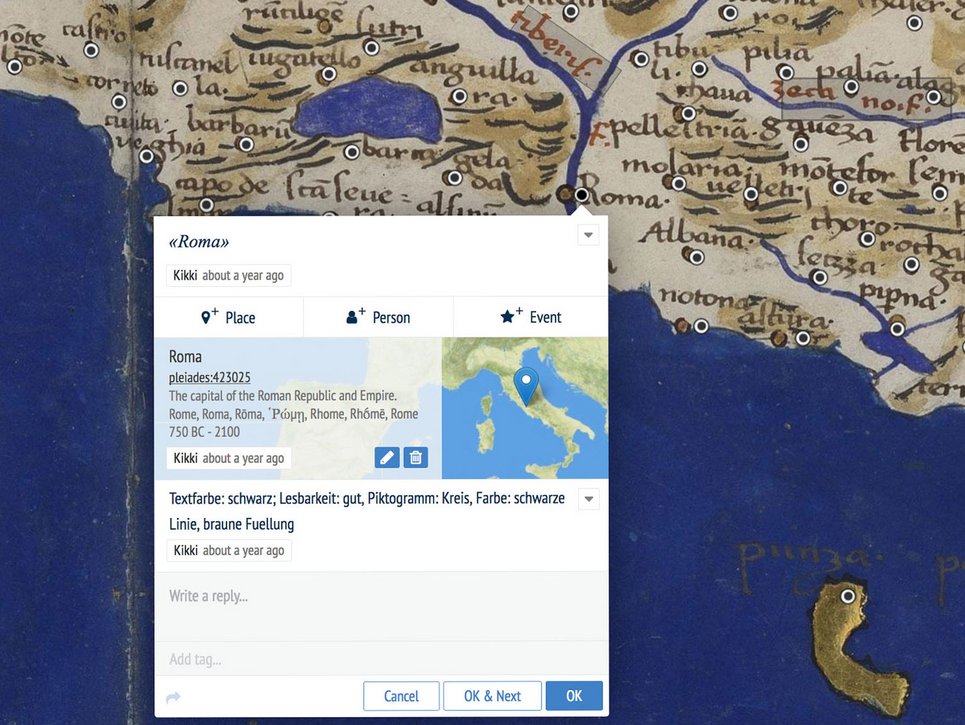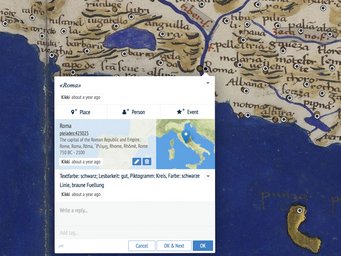Historical Spaces in Flavio Biondo's Italia illustrata (concluded)
A Cognitive-Semantic Analysis in Texts and Maps

By enquiring into the connections between historical maps and texts we can deepen our understanding of historical concepts of space and of the relevant knowledge and learning. Italia illustrata by Biondo is particularly suited to this task because in addition to presenting a topographical framework of places it also details the history of these places – with the author explicitly pointing out that the country had in fact changed a great deal since antiquity and that his text also had to elucidate these changes. Not least due to this approach, Biondo is now regarded as the real founder of archaeology and of antiquarian topography. In Italia illustrata he frequently cites writers from Ancient Rome, such as Livy, Virgil and Pliny. By contrast Greek thinkers such as Strabo and Ptolemy receive little attention – despite the geographical and topographical contents of Biondo's work and despite his intentions for it. One exception is the chapter on Latium ('Regio Latina'), in which Biondo makes copious use of Strabo's writings in a Latin translation (as yet undiscovered). This chapter has been selected for closer analysis in the first instance.
Having established a topological network of places, whose geographical location Biondo is not always able to precisely identify, he then adds historical information. By this means he constructs a space in the early modern era that is as steeped in ancient learning as it is plagued by anxiety over the loss of learning in its own time. The reader thus progresses through a landscape – described with varying degrees of accuracy – travelling known roads and 'glimpsing', one by one, the places that Biondo discusses.
The cognitive maps that underpin or arise from this description of Italy are central to attitudes to space in the past, because they illustrate spatial knowledge and spatial practices that were specific to that civilisation. In order to pursue a more detailed investigation into the linguistic representation of these maps, use is made of analytical methods developed in cognitive linguistics and computational linguistics, in particular natural language processing and semantic text analysis. The focus is on cognitive-semantic parameters such as toponyms, landmarks, spatial reference-frameworks, geometric relations, Gestalt principles and other diverse aspects that can be discerned by dint of the analytic potential of computational linguistics. Using textual and cartographic markers and by applying quantitative methods specific to this body of materials, the text and the maps are reappraised in context and newly interpreted.

There is also the question, closely related to the above, as to whether – and, if so, how – 'many maps' were indeed consulted by Biondo in the preparation of Italia illustrata, as is generally assumed by those currently researching his work. Since very few regional maps from the early fifteenth century have survived and it is all but impossible to identify literary references to cartographic information, potential alternatives have to be discussed in an interdisciplinary approach. Special attention has to be paid to the strategies Biondo used not only to collect his heterogeneous fund of historiographic, geographic, archaeological and art-historical materials but also to filter and process the latter and to transfer these into a text that his own contemporaries would find 'readable'.

